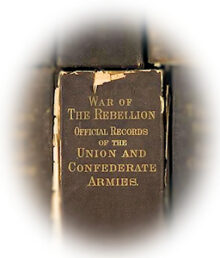FORT SUMTER, S.C., February 5, 1861.
(Received A. G. O., February 8.)
Col. S. COOPER, Adjutant-General:
COLONEL: The character of the work on the end of Cummings Point nearest to us is, I think, now pretty well established. It seems to be a bomb-proof, with embrasures for the guns, the embrasures cut in a sloped wall, formed of heavy timbers, which is now being covered with railroad bars. This battery, though too far off for doing much damage to our walls, unless they have or get heavy rifled guns, will be pretty safe from the effect of our horizontal fires. They appear to be at work to-day connecting this battery with one between it and the battery which fired on the Star of the West, by means of a covered way. Their engineering appears to be well devised and well executed, and their works, even in their present condition, will make it impossible for any hostile force, other than a large and well-appointed one, to enter this harbor, and the chances are that it will then be at a great sacrifice of life. Our 10-inch columbiads are now in position. One points towards the city, one towards Fort Moultrie, and the third can be directed either towards Fort Moultrie or Morris Island. They are at an angle of from 30 ° to 35 °. I tried a shell, a few evenings ago, and we calculated that from a charge of two pounds we got a range of about two thousand yards. I have also four 8-inch seacoast howitzers planted in the area at an angle of 39 °. These bear upon Morris Island. I am now removing the pieces of flagging from the area of our work, as I want it clear, hoping that should any shells fall in it they will probably sink so deep that they will not do much, if any, damage. Captain Foster is engaged in experimenting with one of the iron shutters, trying to see whether we can use them in the lower embrasures. It is very desirable that these embrasures shall be made as secure as possible.
I am, colonel, respectfully, your obedient servant,
ROBERT ANDERSON,
Major, First Artillery, Commanding.
P. S.–Of course, in speaking of forcing an entrance, I do not refer to the little stratagem of a small party slipping in.
FORT SUMTER, S.C.,
February 5, 1861.
General Jos. G. TOTTEN,
Chief Engineer U.S. A., Washington, D.C.:
GENERAL: The sketch upon the margin below gives a pretty correct idea of the position of the works on Cummings Point, thrown up by the South Carolinians. Of course it is subject to errors, arising from the distance at which I am obliged to obtain the information by means of the spy-glass alone.

The lines of the work are not yet complete, the main efforts having been directed to getting ready those guns that are intended to fire upon this work. All the guns that I have indicated by a + are (or appear to be) in position and covered by bomb-proof roofs.
Those at a a are covered by heavy timbers, laid horizontally upon firm timber supports, similar to the marginal sketch. The revetment of the cheeks of the embrasures appear to be formed of palmetto logs, as also the revetment of the interior slope near the guns. The horizontal timbers are large 14-inch raft, sticks, covered apparently by a lighter timber, or planking, running at right angles to the timbers. The guns at a a were being put upon their carriages (which I suspect, from their using a gin in the operation, are some of the barbette carriages <ar1_165> from Castle Pinckney or Fort Moultrie) at the time I wrote to you this morning. Subsequently the rough opening of the embrasures was made and the revetment of the cheeks commenced.

The second bombproof battery is built differently. The timbers on top are sloped at an angle of 45 °, about as in the sketch. They rest upon two horizontal supports parallel to the direction of the battery, one higher than the other, and these are supported by stout posts, about 5 feet from each other. Upon the timbers are placed at right angles a stout planking, and upon this again another covering running up and down. This last consists of railroad iron, apparently the T rail. The work has only progressed thus far, although there is no doubt that the whole is to be covered with sand. The guns are mounted and the openings for embrasures formed.

The work is carried on quite rapidly, considering the heavy nature of the work. The idea of covering the bomb proof with iron and giving it an inclination is no doubt derived from the Sardinian method for forming the sides of a man-of-war, so as to deflect the shot.
A large force of negroes is employed in extending the embankment of the parapet so as to connect this battery with the field work.
The guard-boats are very active at night, and some are always on the watch by day.
Inside this fort the work of preparation goes steadily on. My force is now employed in clearing the parade of the stone flagging. I am also having all the material on hand made into sand bags.
Very respectfully, your obedient servant,
J. G. FOSTER,
Captain, Engineers.
